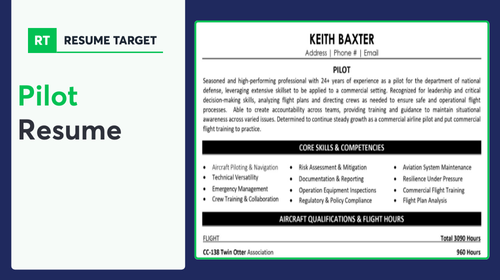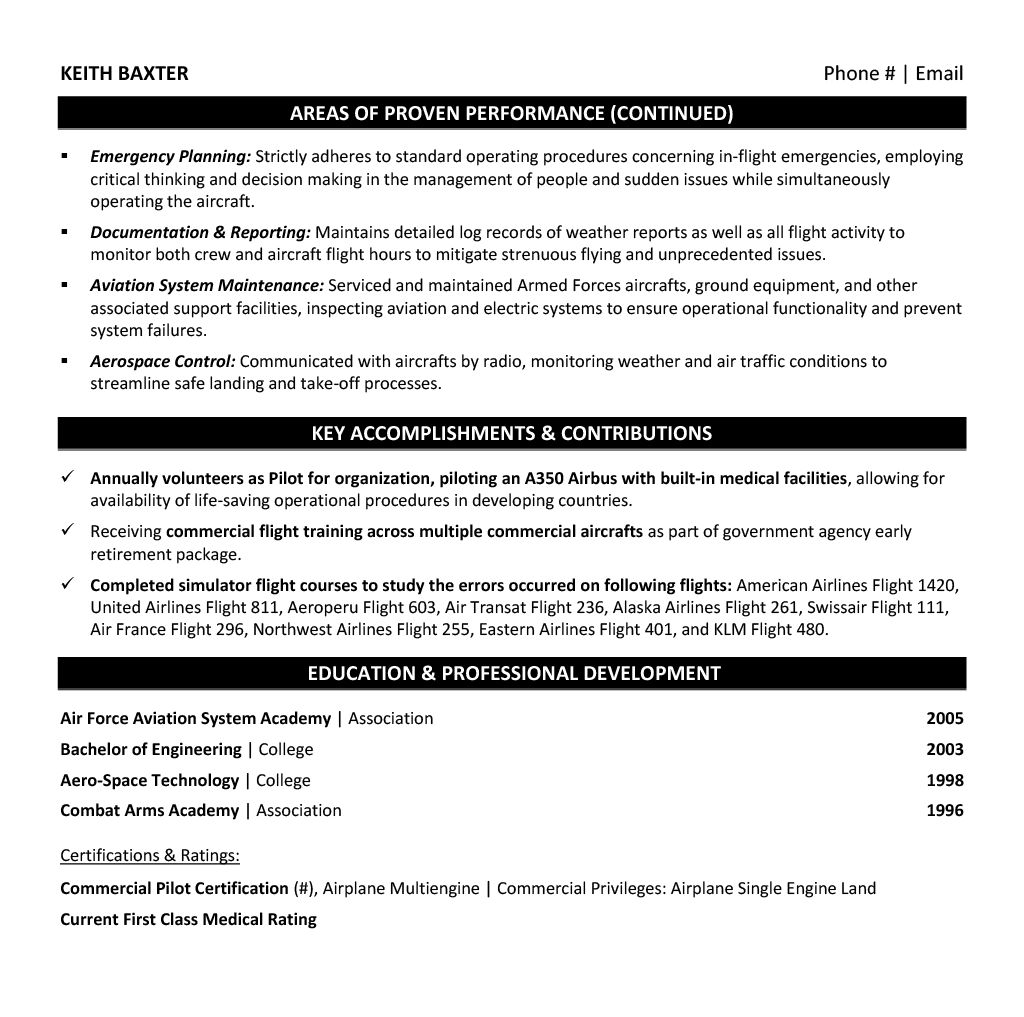

Flying complex aircraft takes skill, but crafting a standout aviation resume can feel like navigating through turbulence. Many pilots struggle to translate their flight hours and technical expertise into compelling career documents.
Are you finding it challenging to showcase your cockpit mastery on paper? Your resume needs to soar above the competition by highlighting both your technical proficiency and your commitment to safety and leadership.
At Resume Target, we understand the unique demands of aviation career advancement. We help pilots create powerful resumes that speak directly to airlines' requirements while showcasing the precise qualifications that hiring managers seek.


From navigating through stormy skies to safely transporting hundreds of passengers across continents, pilots shoulder the extraordinary responsibility of commanding aircraft that can cost upwards of $375 million.
Your role as a pilot extends far beyond just flying the plane—you'll master complex aircraft systems, make split-second decisions based on weather patterns and emergency protocols, coordinate with air traffic control, and maintain constant situational awareness throughout every phase of flight.
Whether you dream of flying commercial jets, private aircraft, or even teaching the next generation of aviators, the journey to becoming a pilot offers multiple career paths and opportunities for advancement as you accumulate flight hours and additional certifications.
Let's talk about what makes a career in aviation so exciting from a compensation perspective! As a pilot, your earning potential soars as high as your aircraft, with commercial and airline pilots enjoying some of the most competitive salaries in the transportation industry. And guess what? Your earnings can really take off as you gain experience and specialize in different types of flying.
Figures from: U.S. Bureau of Labor Statistics
Starting as a pilot begins with earning your Private Pilot License and progresses through various ratings and certifications. Your journey can lead to commanding major commercial aircraft, with opportunities in cargo, corporate, or airline operations.
Beyond mastering the basics of flying, your success as a pilot depends on developing a comprehensive skill set that combines technical expertise with critical thinking and leadership abilities.
Breaking into aviation starts with obtaining your private pilot's license (PPL), followed by building flight hours through entry-level positions while working toward advanced certifications.
Requirements from Wikipedia
Major airlines are on a hiring spree in 2023, with over 13,000 new pilot positions across commercial and cargo sectors.
Figures from Tailwinds of Hope
Staring at a blank screen and wondering how to showcase your flight hours, certifications, and aviation expertise in a way that makes you stand out from other pilots? This comprehensive, section-by-section guide will walk you through creating a professional pilot resume that highlights your aviation achievements and helps you land your dream cockpit position.
As a pilot, you excel at navigating complex flight systems and making split-second decisions, but condensing your impressive aviation career into a few powerful sentences can feel more challenging than managing turbulent weather.
While your expertise in flight operations, safety protocols, and crew management is extensive, translating these specialized skills into a compelling summary that catches a hiring manager's attention requires a different kind of precision - one that can make the difference between landing an interview or getting lost in the stack.
How would you describe your aviation expertise in terms of aircraft types, flight environments, and operational contexts you're most experienced with?
Reason: This helps establish your professional scope and immediately signals to employers your fit for their specific aviation needs. It sets the foundation for your value proposition as a pilot.
What would you say are the top three qualities that have defined your approach to aviation safety and crew leadership throughout your career?
Reason: Safety and leadership are paramount in aviation, and articulating your philosophical approach helps employers understand your professional mindset and cultural fit.
How would you characterize your adaptability across different aviation scenarios, including your comfort with various weather conditions, routes, and mission types?
Reason: Versatility and judgment are crucial pilot attributes, and addressing these upfront helps employers understand your operational flexibility and decision-making capabilities.
As a pilot, you need to showcase both your technical aviation expertise and mandatory certifications while also highlighting crucial soft skills that ensure passenger safety and operational efficiency.
Your skill set should reflect your command of aircraft systems, navigation abilities, and regulatory compliance, while also demonstrating your decision-making capabilities and crew resource management experience.
Note: Would you like me to continue with example skills or additional sections? I've focused on creating a clear, aviation-specific introduction that addresses both the technical and interpersonal aspects of being a pilot while maintaining a professional tone and speaking directly to the reader.Showcase your aviation career by organizing your experience into three powerful sections: a concise role overview highlighting your aircraft types and routes, measurable achievements like flight hours and safety records, and core responsibilities that demonstrate your command of flight operations and crew leadership.
Many pilots struggle to effectively communicate their operational excellence and safety record beyond basic flight hours and certifications. Transform your experience into compelling achievements by connecting your flight expertise to measurable outcomes in safety, efficiency, and operational cost savings.
The responsibilities section demonstrates how Pilots ensure safe and efficient aircraft operations while managing complex systems and crew coordination. Your duties should highlight both technical expertise and leadership abilities in ways that showcase your contribution to passenger safety and airline operations.
Your pilot credentials and aviation education are crucial elements that demonstrate your qualifications to potential employers. Lead with your highest level pilot certificates and ratings, followed by your formal education and specialized training endorsements that showcase your expertise in specific aircraft or operations.
Now that you've built a strong foundation using Resume Target's proven resume writing guidelines, you're ready to transform your aviation credentials into a powerful, position-specific document.
While many pilots focus solely on customizing their cover letters, tailoring your actual resume for specific airline positions and aircraft types can make a dramatic difference in your application success rate.
A customized pilot resume not only helps you navigate through sophisticated ATS systems by incorporating the right aviation keywords, but it also demonstrates to hiring managers that your specific flight experience and certifications align perfectly with their operational needs.
Ready to make your pilot resume soar above the competition? Let's transform your credentials into a targeted document that lands you in the captain's seat!
Just starting your journey into aviation? Your lack of commercial flight hours doesn't have to ground your career aspirations.
Even without extensive cockpit time, you can create an impressive resume by highlighting your flight training, certifications, and hands-on experience from flight school.
Focus on showcasing your flight certifications, logged hours, and simulator experience to demonstrate your readiness for the cockpit.
For more guidance on structuring your aviation credentials, check out the Student Resume Writing Guide to help your application take flight.
Your aviation journey has equipped you with valuable skills and certifications that deserve to be showcased front and center on your resume.
Transform your flight training hours, simulator experience, and educational achievements into a compelling narrative that demonstrates your readiness for the cockpit.
"Detail-oriented and safety-focused commercial pilot with 250+ flight hours and newly acquired CPL certification. Demonstrated proficiency in single and multi-engine aircraft operations, with exceptional situational awareness and communication skills developed through intensive flight training. Maintained perfect safety record throughout training while mastering advanced navigation systems and emergency procedures. Seeking First Officer position to contribute strong technical abilities and unwavering commitment to aviation safety."
Now's your chance to showcase the rigorous training and certifications that make you a qualified aviator - let's make your educational background really take flight!
Transform your flight school experience into compelling content by highlighting specialized coursework like instrument rating training, cross-country navigation, and emergency procedures, plus include key flight projects like your first solo or commercial certification milestones.
unavailableRelevant Coursework: Aviation Navigation Systems | Aircraft Systems and Operations | Aviation Safety | Flight Theory and Aerodynamics | Aviation Weather | Aviation Regulations and Law
Key Projects:
Flight Planning Optimization Project: Developed comprehensive flight plans incorporating weather patterns, fuel efficiency, and route optimization for long-haul commercial flights. Created and validated multiple scenarios using industry-standard flight planning software.
Aircraft Systems Integration Simulation: Led a team of four student pilots in conducting advanced systems integration testing using full-motion flight simulators for commercial aircraft operations.
Leverage your flight training, certification achievements, and hands-on experience to create a compelling skills section that showcases your readiness for commercial aviation responsibilities.
As an entry-level pilot, your foundation in aviation fundamentals positions you well for career advancement in an industry that continues to experience growing demand for qualified flight professionals.
When you've spent thousands of hours in the cockpit mastering complex aircraft systems and safety protocols, it can feel impossible to capture all that expertise in a way that truly resonates with hiring managers.
At Resume Target, we specialize in crafting powerful pilot resumes that showcase both your technical proficiency and leadership capabilities in the aerospace industry.
Our team has helped countless pilots successfully transition between commercial, private, and military aviation roles by highlighting the exact qualifications employers want to see.
With major airlines actively expanding their fleets and new opportunities emerging across the aviation sector, now is the perfect time to ensure your resume positions you for that next career milestone - let's get started with a free consultation today.
Impress any hiring manager with our aviation resume writing service. We work with all career levels and types of aviation professionals.
Learn More → Aviationg Resume Writing Services